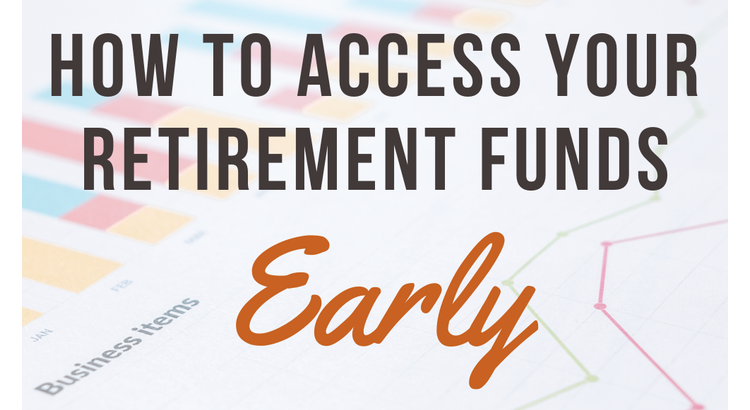Investing for your retirement is actually pretty easy to get right. However, the rules governing retirement accounts are often anything but straightforward. In my previous role at the investment firm I work for, I assisted hundreds of alternative asset investors using “self-directed” IRA accounts. These investors are typically savvier than the average 401k holder but even they are often unclear about the rules determining contributions, and perhaps more importantly, how to access retirement funds early, without being penalized.
Though a number of personal factors, as well as the account/plan type, dictate an investor’s options, there are numerous way to access retirement funds early for the most commonly held retirement vehicles, IRAs, HSAs and 401(k)s. Of course, the drawback of taking money from any retirement vehicle is that the funds cannot return to the account in the same tax year, causing investors to lose out on the power on compounding interest, from those contributions. Given how low annual contribution thresholds are and how beneficial the tax-sheltered structure of these accounts are, it’s almost always preferable to tap other sources for cash first.
Let’s take a look at some of the most useful ways to access retirement funds before retirement age, without penalty.
1. Get your contributions back, tax/penalty free
Accounts: Roth IRAs, other “post-tax” vehicles
Though it’s one of the biggest benefits of the Roth IRA, I am always surprised how few investors are aware of this tax and penalty free method of accessing retirement funds early. Because Roth IRAs are funded with post-tax money, Roth IRA contributions can be withdrawn at any time, for any reason, without further tax or penalty. You just have to be careful not to withdraw any interest or earnings that have accumulated in the account. Removing those funds early will cause you to be steeply penalized. Fortunately, whenever you take money from your IRA, your contributions are withdrawn first. So, as long as you are tracking your investments, it’s hard to mistakenly withdraw interest and other returns from investments.
Related: Valuist best FREE automatically updating, investment tracking and asset allocation tools
2. Exchange receipts for medical bills, over several years, for cash back now (regardless of AGI).
Accounts: Health Savings Accounts (HSAs)
HSAs can also be used for reimbursements of medical expenses, now, or in future years. That is, you can pay your current, qualified medical expenses out-of-pocket today and withdraw amounts paid from your account in future years (tax and penalty free). This effectively allows you to use an HSA as additional emergency funds, especially when you are younger, working and healthy.
Another powerful function of Health Savings Accounts is that, like IRAs and 401(k)s, they can be actively invested. HSA funds can be invested into bonds, mutual funds and even real estate or other alternative investments, to supercharge your returns. A well invested HSA could potentially fund your entire medical care needs during retirement. Fidelity demonstrated how a couple might need as much as $295,000 to cover medical costs in retirement, so, an HSA returning 7-9% makes attaining that monumental savings goal far easier.
3. Pay your health insurance premiums when you are unemployed
Accounts: Individual Retirement Accounts (IRAs)
When you are unemployed, you can tap into your retirement accounts to cover health insurance premiums . This is great news given that without insurance, a catastrophic medical event can quickly decimate your savings, or your health. Though I once wrote about why I chose to go without insurance for a year, with the COVID 19 pandemic continuing to wreak havoc on the health care system and the economy, it has never been a better time to be insured.
An added benefit of most retirement vehicles is that they may be used, penalty free, for medical expenses above certain annual amounts (and depending on AGI). This exemption can drastically help reduce the financial hit during years when medical costs are especially high.
4. Take a loan from your retirement plan
Accounts: 401(k)s and other Defined Benefits plans
With a 401(k) you may generally borrow 50% of the account balance, up to $50,000, without incurring taxes or penalties. This is a unique benefit to 401(k) plans and other DB plans as you cannot take loans from your IRA. Money withdrawn from an IRA for any reason can never return to the account, which, of course, reduces future returns.
However, there are also several drawbacks to taking a loan from your 401(k). For one, you typically only have 5 years to repay it and, you must include interest! Further, if you get fired or quit your job you may have two to three months to pay back the entire loan. Also, if you miss a payment, you will be taxed on the balance of the loan, according to your income tax rate. You also must use post-tax dollars to pay back the loan, which further increases the cost of the loan. Coupled with the opportunity loss of removing funds for any amount of time, a loan from a 401(k) is only recommended if absolutely necessary and/or you plan to pay it back quickly.
5. First-time home buyer (up to $10,000)
Accounts: IRAs
Perhaps more commonly utilized by investors than the other methods of accessing retirement funds early, the first time home buyer exemption helps new home buyers with the incredibly high costs of purchasing and owning your home. An added benefit is that, because IRAs are individual accounts, both you and your spouse can take advantage of this exemption. Unlike traditional IRAs, which are funded by pretax dollars, for Roth IRAs you must have had the account open for at least 5 years before touching the principal balance. Contributions to a Roth may always be withdrawn tax and penalty free.
6. Receive your funds in equal payments for the rest of your life
Accounts: qualified retirement accounts, 401(k)s (except those held with current employer)
This is probably one of the most powerful tools for early access of retirement funds, as well as the least utilized. If you want to discontinue your retirement account and access all of your retirement money early, you can start taking distributions, whenever you want, through a Substantially Equal Periodic Payments (SEPP) arrangement. This arrangement returns your entire retirement account, contributions and earnings, over time. SEPP works well for those whose career may have ended prematurely and need early access to cash, or for those entering early retirement with other income sources.
The drawbacks of this plan are that account holders may no longer contribute to the account and once an election to distribute via SEPP is made it must be maintained to avoid penalty, sometimes for decades. If the plan is cancelled prior to the minimum holding period expiring, all penalties and interest are retroactively incurred. Fortunately, one of the distribution options is to have the account fully returned over just 5 years. So, if you are able to amass a large amount in your IRA and have other funds to draw from and other investment vehicles to contribute to, you can get to your IRA funds relatively quickly through a SEPP arrangement.
7. Quit your job and retire earlier
Accounts: 401(k)s
If you contribute to a 401K plan you can access retirement funds 4.5 years early by simply, “separating from service.” Typically, retirement starts at 59.5, at which point you can take retirement distributions while avoiding the 10% penalty for early withdrawal. However, if you are ready to retire at 55 you can shave a few years off of the clock. The only caveat to early access of 401(k) funds is that you must quit your job. Not a bad trade off for early retirement.
8. Certain higher education expense
Accounts: IRAs
Good news for parents who are strapped for cash due to rising cost of college, you can use funds from an IRA to cover tuition, room and board, books and equipment. To avoid the 10% early withdrawal penalty, the expenses must be for a student (you, your spouse, children or grandchildren) enrolled at least half time in a degree program. You must also demonstrate that the student is enrolled in an accredited institution and you will still be required to pay income tax on the withdrawal for a traditional IRA. For a Roth IRA, you may always deduct contributions but may not touch the principal, even through exemptions to the 10% withdrawal penalty, until the account has matured for 5 years.
For much more information about IRA withdrawals, check out this publication from the IRS


